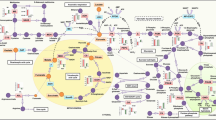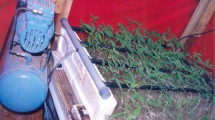Abstract
Phosphorus-deficient rape plants appear to acidify part of their rhizosphere by exuding malic and citric acid. A simulation model was used to evaluate the effect of measured exudation rates on phosphate uptake from Mali rock phosphate. The model used was one on nutrient uptake, extended to include both the effect of ion uptake and exudation on rhizosphere pH and the effect of rhizosphere pH on the solubilization of rock phosphate. Only the youngest zones of the root system were assumed to exude organic acids. The transport of protons released by organic acids was described by mass flow and diffusion. An experimentally determined relation was used describing pH and phosphate concentration in the soil solution as a function of total soil acid concentration. Model parameters were determined in experiments on organic acid exudation and on the uptake of phosphate by rape from a mixture of quartz sand and rock phosphate.
Results based on simulation calculations indicated that the exudation rates measured in rape plants deficient in phosphorus can provide the roots with more phosphate than is actually taken up. Presence of root hairs enhanced the effect of organic acid exudation on calculated phosphate uptake. However, increase of root hair length without exudation as an alternative strategy to increase phosphate uptake from rock phosphate appeared to be less effective than exudation of organic acids.
It was concluded that organic acid exudation is a highly effective strategy to increase phosphate uptake from rock phosphate, and that it unlikely that other rhizosphere processes play an important role in rock phosphate mobilization by rape.
Similar content being viewed by others
References
Anonymous 1989 Methods of Biochemical Analysis and Food Analysis Using Single Reagents. Boehringer Mannheim GmbH, Mannheim, Germany.
Bekele T, Cino B J, Ehlert P A J, Van derMaas A and VanDiest A 1983 An evaluation of plant-borne factors promoting the solubilization of alkaline rock phosphate. Plant and Soil 75, 361–378.
Bhat K K S and Nye P H 1973 Diffusion of phosphate to plant roots in soil. I. Quantitative autoradiography of the depletion zone. Plant and Soil 38, 161–175.
Brewster J L, Bhat K K S and Nye P H 1976 The possibility of predicting solute uptake and plant growth response from independently measured soil and plant characteristics. V. The growth and phosphorus uptake of rape at a range of phosphorus concentrations and a comparison of results with the predictions of a simulation model. Plant and Soil 44, 295–328.
Föhse D, Claassen N and Jungk A 1991 Phosphorus efficiency of plants. II. Significance of root radius, root hairs and cation-anion balance for phosphorus influx in seven plant species. Plant and Soil 132, 261–272.
Hedley M J, Nye P H and White R E 1982 Plant-induced changes in the rhizosphere of rape (Brassica napus cv. Emerald) seedlings. II. Origin of the pH change. New Phytol. 91, 31–44.
Hedley M J, Nye P H and White R E 1983 Plant-induced changes in the rhizosphere of rape (Brassica napus cv. Emerald) seedlings. IV. The effect of rhizosphere phosphorus status on the pH, phosphatase activity and depletion of soil phosphorus fractions in the rhizosphere and on the cation-anion balance in plants. New Phytol. 95, 69–82.
Hoffland E, Findenegg G R and Nelemans J A 1989a Solubilization of rock phosphate by rape. I. Evaluation of the role of the nutrient uptake pattern. Plant and Soil 113, 155–160.
Hoffland E, Findenegg G R and Nelemans J A 1989b Solubilization of rock phosphate by rape. II. Local root exudation of organic acids as a response to P-starvation. Plant and Soil 113, 161–165.
Hoffland E, Bloemhof H S, Leffelaar P A, Findenegg G R and Nelemans J A 1990a Simulation of nutrient uptake by a growing root system considering increasing root density and inter-root competition. Plant and Soil 124, 149–155.
Hoffland E, Findenegg G R, Leffelaar P A and Nelemans J A 1990b Use of a simulation model to quantify the amount of phosphate released from rock phosphate by rape. Trans. 14th Int. Congr. Soil Sci. (Kyoto) II, 170–175.
Johnston W B and Olsen R A 1972 Dissolution of fluorapatite by plant roots. Soil Sci. 114, 29–36.
Khasawneh F E and Doll E C 1978 The use of phosphate rock for direct application to soils. Adv. Agron. 30, 159–206.
Kirk G J D and Nye P H 1986 A simple model for predicting the rates of dissolution of sparingly soluble calcium phosphates in soil. I. The basic model. J. Soil Sci. 37, 529–540.
Moorby H, White R E and Nye P H 1988 The influence of phosphate nutrition on H ion efflux from the roots of young rape plants. Plant and Soil 105, 247–256.
Nye P H 1982 The measurement and mechanism of ion diffusion in soils. VIII. A theory for the propagation of changes of pH in soils. J. Soil Sci. 23, 82–92.
Nye P H 1983 The diffusion of two interacting solutes in soil. J. Soil Sci. 34, 677–691.
Nye P H 1984 pH changes the phosphate solubilization near roots — an example of coupled diffusion processes. In Roots, Nutrient and Water Influx, and Plant Growth. Eds. S ABarber, D RBouldin and D MKral. pp 89–100. ASA Spec. Publ. 49. Soil Sci. Soc. Am., Madison, WI.
Author information
Authors and Affiliations
Rights and permissions
About this article
Cite this article
Hoffland, E. Quantitative evaluation of the role of organic acid exudation in the mobilization of rock phosphate by rape. Plant Soil 140, 279–289 (1992). https://doi.org/10.1007/BF00010605
Received:
Issue Date:
DOI: https://doi.org/10.1007/BF00010605




